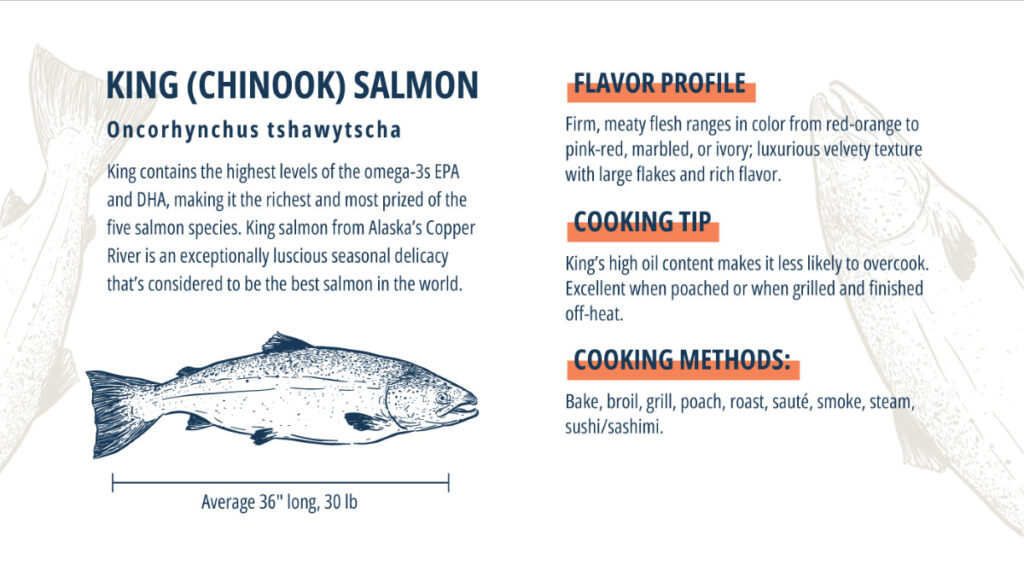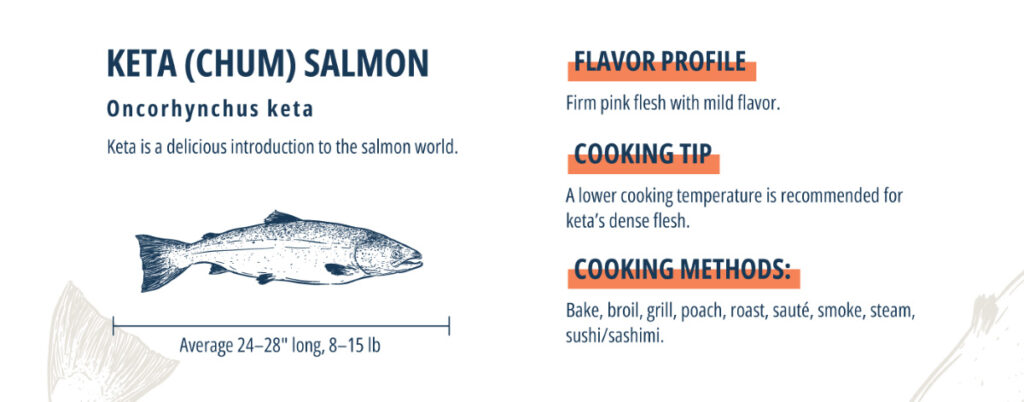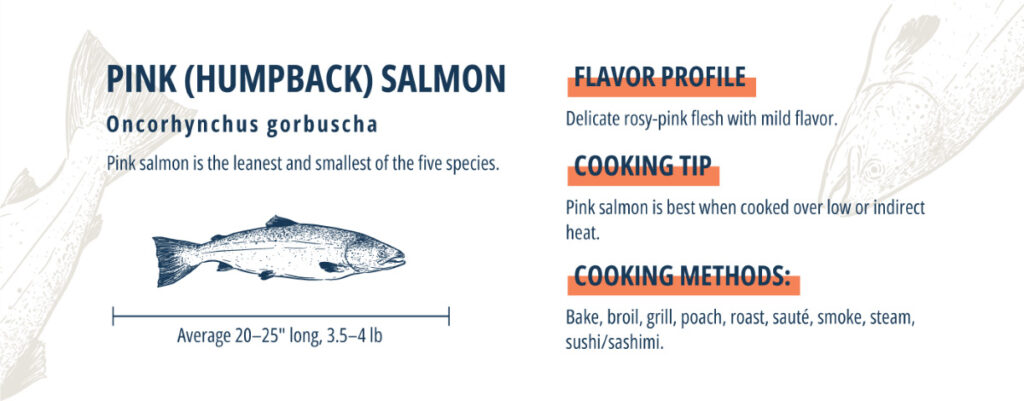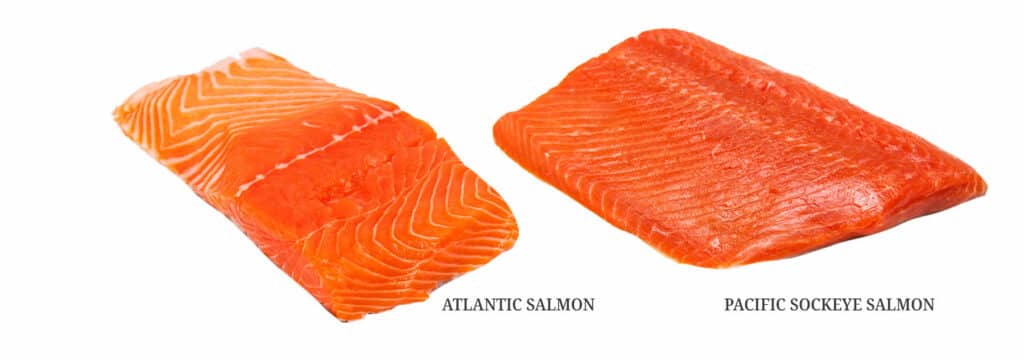Introduction
The world of salmon is filled with a variety of species, each with its own unique characteristics. Two of the most well-known and widely consumed types of salmon are Atlantic salmon and Pacific salmon. While both belong to the same family, there are key differences in their flavor, texture, and appearance. Understanding these differences can help you make informed choices when it comes to selecting and preparing salmon for your meals. In this article, we will explore the distinct characteristics of Atlantic and Pacific salmon, their nutritional compositions, recommended cooking methods, and considerations when choosing between the two. So, join us as we dive into the flavorful world of Atlantic salmon vs Pacific salmon.
Introduction To Atlantic Salmon And Pacific Salmon
Atlantic Salmon and Pacific Salmon are two distinct species of salmon that differ in terms of their flavor, texture, and appearance. Atlantic Salmon, also known as Salmo salar, is native to the Atlantic Ocean and has been extensively farmed for commercial purposes. On the other hand, Pacific Salmon encompasses several species, including Chinook, Coho, Sockeye, Pink, and Chum salmon, which are mostly found in the waters of the Pacific Ocean. Each species has its own unique characteristics and regional distinctions, making them popular choices among seafood enthusiasts worldwide. Understanding the differences between these two types of salmon can help individuals make informed decisions when it comes to selecting and preparing these delicious fish.
Key Differences Between Atlantic Salmon And Pacific Salmon
The key differences between Atlantic Salmon and Pacific Salmon lie in their flavor, texture, and availability. Atlantic Salmon, with its soft consistency and mild flavor, is lighter in color compared to the richer and more robust-flavored Pacific Salmon. Atlantic Salmon is readily available year-round, thanks to fish farms, while Pacific Salmon is more seasonal and its availability depends on the timing of spawning season returns. These distinctions make both types of salmon unique and provide seafood enthusiasts with different options to choose from based on their preferences and the occasion.
Atlantic Salmon

Atlantic Salmon, also known as Salmo salar, is a species of salmon found primarily in the northern Atlantic Ocean. It is renowned for its delicate flavor and tender texture, making it a popular choice among seafood lovers. Atlantic Salmon has a light pink color, softer flesh, and a milder flavor compared to its Pacific counterpart. This makes it versatile in various preparations, including grilling, baking, or poaching. Thanks to fish farming, Atlantic Salmon is available year-round and is widely accessible in supermarkets and seafood markets. Its mild taste and tender flesh make it a favorite among those who prefer a lighter seafood option.
Atlantic Salmon Flavor Profile
Atlantic Salmon is known for its delicate flavor that is mild and subtle compared to its Pacific counterpart. It has a pleasant, buttery taste with a hint of sweetness. The flavor profile of Atlantic Salmon is often described as being less intense and more delicate, making it a preferred choice for those who prefer a lighter seafood option. Whether grilled, baked, or poached, Atlantic Salmon retains its mild flavor, allowing it to pair well with a variety of seasonings and ingredients to create delicious and versatile dishes.
Texture And Appearance Of Atlantic Salmon
Atlantic Salmon has a distinct texture and appearance that sets it apart from Pacific Salmon. The flesh of Atlantic Salmon is known for its softer, more delicate texture compared to the firmer and more robust flesh of Pacific Salmon. Additionally, Atlantic Salmon has larger flakes, giving it a flakier and more melt-in-your-mouth consistency. In terms of appearance, Atlantic Salmon has a lighter pink color compared to the richer color of Pacific Salmon. These differences in texture and appearance contribute to the overall experience and enjoyment of Atlantic Salmon as a seafood option.
Pacific Salmon

Pacific Salmon is a popular type of salmon known for its rich flavor and vibrant color. Its flesh is firm and has smaller flakes compared to Atlantic Salmon. Pacific Salmon has a bolder taste and a deeper pink or orange color, which is attributed to its natural diet of krill and other marine organisms. This species includes several varieties such as King (Chinook), Coho (Silver), Sockeye (Red), and Pink Salmon. Pacific Salmon is highly prized for its nutritional value, including high levels of omega-3 fatty acids and vitamin D. Cooking methods such as grilling, baking, or broiling bring out the full flavor and texture of Pacific Salmon.
Pacific Salmon Flavor Profile
Pacific Salmon is known for its bold and robust flavor. Its flesh has a distinct, rich taste that is often described as slightly sweet and nutty. The flavor can vary between different varieties of Pacific Salmon, with King Salmon (Chinook) being the most intensely flavored and Sockeye (Red) Salmon having a stronger, more pronounced taste. The natural oils present in Pacific Salmon contribute to its flavorful profile, making it a popular choice for those who prefer a stronger taste. Whether grilled, baked, or broiled, Pacific Salmon retains its delicious flavor and pairs well with a variety of seasonings and sauces.
Texture And Appearance Of Pacific Salmon
Pacific Salmon has a firmer texture compared to Atlantic Salmon. Its flesh is dense and moist, with smaller flakes that hold together well during cooking. Visually, Pacific Salmon has a deeper color, ranging from vibrant red to rich orange, depending on the species. Its skin is usually silver with black spots, known as “tiger stripes,” adding to its distinctive appearance. The flesh of Pacific Salmon is known for its natural oils, which contribute to its rich and buttery mouthfeel. When cooked, Pacific Salmon maintains its firm texture and attractive color, making it a visually appealing choice for any dish.
Nutritional Differences

The nutritional differences between Atlantic Salmon and Pacific Salmon are relatively minimal. Both types of salmon are excellent sources of protein and omega-3 fatty acids, which have numerous health benefits. However, there are some slight variations in their nutritional compositions. Atlantic Salmon tends to have slightly higher fat content, making it slightly more calorie-dense compared to Pacific Salmon. Pacific Salmon, on the other hand, may have slightly higher levels of certain vitamins and minerals due to differences in their feeding habits. Overall, both Atlantic and Pacific Salmon offer a nutritious and delicious addition to a balanced diet.
Nutritional Composition Of Atlantic Salmon
Atlantic Salmon is known for its high nutritional value. It is a rich source of protein, omega-3 fatty acids, and essential vitamins and minerals. In terms of macronutrients, Atlantic Salmon contains about 22 grams of protein per 3-ounce serving, making it an excellent choice for those looking to meet their protein needs. It is also high in healthy fats, with around 13 grams of fat per serving, including omega-3 fatty acids that are beneficial for heart health. Additionally, Atlantic Salmon is a good source of important vitamins such as vitamin B12, vitamin D, and vitamin E, as well as minerals like selenium and potassium. These nutrients contribute to overall health and wellbeing. So, including Atlantic Salmon in your diet can provide you with a well-rounded nutritional profile.
Nutritional Composition Of Pacific Salmon
Pacific Salmon is also highly nutritious, offering a range of health benefits. Like Atlantic Salmon, Pacific Salmon is a good source of protein, with about 22 grams per 3-ounce serving. It is also rich in healthy fats, including omega-3 fatty acids, which are important for heart health. Additionally, Pacific Salmon contains essential vitamins and minerals, such as vitamin B12, vitamin D, and selenium. These nutrients contribute to supporting brain function, promoting healthy bones, and strengthening the immune system. Including Pacific Salmon in your diet can help provide a well-rounded nutritional profile.
Cooking And Preparation

Cooking and preparing Atlantic Salmon and Pacific Salmon requires different techniques to bring out their best flavors and textures.
When it comes to Atlantic Salmon, its delicate and buttery flavor is best preserved through gentle cooking methods such as baking, grilling, or poaching. Due to its softer texture, it is important to handle Atlantic Salmon with care to prevent it from breaking apart during cooking.
On the other hand, Pacific Salmon’s bolder taste and firmer texture make it ideal for more robust cooking methods like broiling, pan-searing, or even smoking. Its sturdier flesh can withstand higher temperatures and longer cooking times.
Whether you’re cooking Atlantic Salmon or Pacific Salmon, it is essential to season the fish well with your favorite herbs, spices, and marinades to enhance its flavor profile. Pairing it with citrus, dill, or a tangy glaze can also provide a refreshing contrast.
Ultimately, the cooking and preparation methods chosen for Atlantic Salmon or Pacific Salmon should complement their unique characteristics to create a delicious and memorable dining experience.
Recommended Cooking Methods For Atlantic Salmon
Recommended cooking methods for Atlantic Salmon include baking, grilling, and poaching. These gentle cooking techniques help preserve the delicate and buttery flavor of Atlantic Salmon. Baking the salmon in the oven allows for even cooking and a moist texture. Grilling gives the salmon a smoky and charred flavor, while poaching in a flavorful liquid helps retain its tenderness. When preparing Atlantic Salmon, it is important to handle it with care to prevent it from breaking apart during cooking. Seasoning the fish with herbs, spices, and marinades enhances its flavor profile.
Recommended Cooking Methods For Pacific Salmon
Recommended cooking methods for Pacific Salmon include grilling, broiling, and pan-searing. These methods help enhance the rich flavor and firm texture of Pacific Salmon. Grilling the salmon over direct heat imparts a smoky charred taste. Broiling allows for quick and even cooking, resulting in a crispy exterior and a moist interior. Pan-searing in a hot skillet with a small amount of oil creates a golden crust while keeping the fish tender and juicy. Seasoning with herbs, spices, and citrus can add a burst of freshness to the Pacific Salmon.
Conclusion

In conclusion, the differences between Atlantic salmon and Pacific salmon may be minimal, especially when it comes to taste and texture. Both types of salmon offer their own unique flavors and textures, with Pacific salmon being known for its rich flavor and smaller, more tender flakes, while Atlantic salmon has a milder taste. However, for the average person, these distinctions may not be easily discernible. Ultimately, choosing between Atlantic and Pacific salmon comes down to personal preference and availability. Both options provide a nutritious and delicious choice for any seafood lover.
Summary Of Flavor, Texture, And Nutritional Differences
The flavor and texture of Atlantic salmon and Pacific salmon differ slightly. Atlantic salmon has a milder taste and softer texture, with larger flakes, while Pacific salmon offers a richer flavor and smaller, more tender flakes. In terms of nutrition, both types of salmon are high in omega-3 fatty acids and protein. However, wild Pacific salmon may have a slightly higher omega-3 content due to its natural diet. Ultimately, the choice between Atlantic and Pacific salmon comes down to personal preference and availability.
Considerations When Choosing Between Atlantic Salmon And Pacific Salmon
When choosing between Atlantic Salmon and Pacific Salmon, there are a few considerations to keep in mind.
- Availability: Atlantic Salmon is more readily available in stores, as it is widely farmed. Pacific Salmon, on the other hand, is primarily caught wild and may have seasonal availability.
- Sustainability: Pacific Salmon is often preferred by those who prioritize sustainability, as it is more likely to be wild-caught. Be sure to look for sustainability certifications when purchasing.
- Personal Preference: Ultimately, the choice between Atlantic and Pacific Salmon comes down to personal preference. Consider the flavor, texture, and appearance that you prefer, and try both types to see which one suits your palate best.
By considering these factors, you can make an informed decision when choosing between Atlantic Salmon and Pacific Salmon.
FAQ: Atlantic Salmon vs Pacific Salmon
Q: What is the main difference between Atlantic salmon and Pacific salmon?
A: The main difference lies in the species and their habitats. Atlantic salmon (Salmo salar) is native to the Atlantic Ocean, while various species of Pacific salmon (Oncorhynchus genus) are found in the Pacific Ocean.
Q: Are there any physical differences between the two types of salmon?
A: Yes, there are several physical differences. Atlantic salmon typically have a slimmer body, a longer snout, and a smaller tail. Pacific salmon, on the other hand, have a rounder body, a shorter snout, and a larger tail.
Q: What are some common species of Pacific salmon?
A: Some common species of Pacific salmon include Chinook (also known as King), Sockeye, Coho, Pink, and Chum salmon. Each species has distinct characteristics and flavors.
Q: Which type of salmon is more commonly found in North America?
A: Pacific salmon is more commonly found in North America, particularly along the coast of Alaska and the Pacific Northwest. Atlantic salmon is not native to North America, although it is farmed in some regions.
Q: Do Atlantic salmon and Pacific salmon have different flavors?
A: Yes, there are flavor differences between the two. Atlantic salmon is known for its milder, buttery flavor, while Pacific salmon often has a richer, more pronounced taste. However, individual preferences may vary.
Q: Are there any nutritional differences between Atlantic and Pacific salmon?
A: Both types of salmon are excellent sources of protein, omega-3 fatty acids, and various vitamins and minerals. However, some studies suggest that Pacific salmon may contain slightly higher levels of omega-3 fatty acids.
Q: Can you clarify the differences in color between the two types of salmon?
A: Atlantic salmon tends to have a lighter pink color, while Pacific salmon generally displays a richer hue. The variation in color is due to differences in diet and habitat.
Q: Is one type of salmon considered healthier than the other?
A: Both Atlantic and Pacific salmon offer numerous health benefits. However, it’s important to note that wild-caught salmon, whether Atlantic or Pacific, is generally considered to be healthier than farmed salmon due to differences in diet, living conditions, and potential exposure to contaminants.
Q: Which type of salmon is more commonly available in supermarkets?
A: In North America, you are more likely to find Pacific salmon varieties, such as Chinook, Sockeye, and Coho, in supermarkets. However, Atlantic salmon is also widely available, primarily as a farmed product.
Q: Are there any sustainability concerns related to the consumption of Atlantic or Pacific salmon?
A: Sustainability concerns exist for both types of salmon due to overfishing, habitat destruction, and pollution. It is recommended to choose sustainably sourced salmon products and support responsible fishing practices.
Q: Can you suggest some cooking methods that work well for both types of salmon?
A: Grilling, broiling, baking, and pan-searing are popular cooking methods for both Atlantic and Pacific salmon. You can also enjoy them raw in sushi and sashimi dishes. The key is to cook the salmon until it is opaque and flakes easily.
In conclusion, while Atlantic and Pacific salmon share some similarities, such as being highly nutritious and delicious, they have distinct characteristics in terms of species, habitats, flavors, and availability. Both options can be enjoyed as part of a healthy and varied diet, and it ultimately comes down to personal preference.

From At-Home Dinner Parties to Family Reunions to Office Parties, we can cater your next Event!